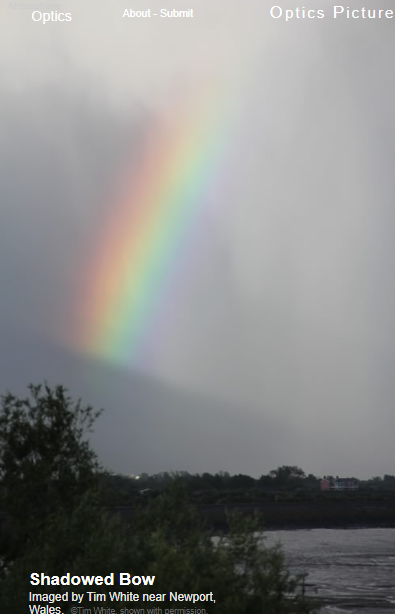OPOD - Shadowed Bow
OPOD - Shadowed Bow: A Captivating Optical Phenomenon
Have you ever witnessed a shadowed bow in the sky? If not, let me take you on a journey to discover this captivating atmospheric optics phenomenon. In this article, we will explore the intricacies of shadowed bows, their formation, and the mesmerizing colors they exhibit.
Unveiling the Colors of the Shadowed Bow
When you first lay eyes on a shadowed bow, you might be deceived into thinking that the colors you see are pure spectral hues. However, the truth is that, except for the extreme reds, the colors of the shadowed bow are actually mixtures of different hues. This intriguing blend of colors adds to the enchantment of this optical phenomenon.
The Rainbow Wheel Effect
The dark shadow observed in the shadowed bow is a manifestation of the "rainbow wheel" effect. Raindrops present in the half of the sky opposite to the sun act as tiny prisms, reflecting and refracting sunlight to create rainbows. These rainbows are visible when the raindrops are in sunlight and not overshadowed by clouds.
It is fascinating to note that even though a cloud shadow appears as a parallel-sided tube of unlit air, it seems to converge with distance towards a point directly opposite the sun, known as the anti-solar point. Sometimes, when the shadow and the adjacent sunlit air are visible together, they form captivating anticrepuscular rays.
The Impact of Cloud Shadows on Rainbows
When a cloud shadow falls over raindrops that form a rainbow, the optical effect becomes even more pronounced. The raindrops no longer glint, resulting in the rainbow appearing cut off. The light from the rainbow extends well inside the colored rim as a white glow, but this glow is also truncated, leaving behind a dark wedge in the sky. In some instances, when several small cloud shadows converge, they create the illusion of a spoked rainbow, resembling the spokes of a wheel.
The Intriguing Spoked Effect
The spoked effect of the shadowed bow occurs when multiple small clouds cast shadows over the raindrops forming the rainbow. These clouds can be located in the opposite part of the sky rather than being in close proximity to the bow itself. The interplay between these clouds and the rainbow-forming raindrops generates a mesmerizing display of spokes, further enhancing the allure of this optical phenomenon.
A Captivating Visual Experience
Witnessing a shadowed bow is truly a captivating visual experience. The play of light and shadow, the mixture of colors, and the intricate patterns formed by the converging cloud shadows create a spectacle that delights the eyes and sparks curiosity. It serves as a reminder of the beauty and complexity present in our natural world.
Conclusion
In conclusion, shadowed bows are a captivating atmospheric optics phenomenon that showcases the interplay between light, raindrops, and cloud shadows. The colors observed in these bows are a beautiful blend of hues, with only the extreme reds appearing as pure spectral colors. The "rainbow wheel" effect, coupled with the interaction between cloud shadows and rainbows, gives rise to the mesmerizing spoked effect seen in some instances. So, keep your eyes on the sky, for you never know when you might catch a glimpse of this enchanting optical display.

Shadowed Bow
Imaged by Tim White near Newport, Wales. ©Tim White, shown with permission.
This bow shows beautiful colours. One could believe that they are pure spectral colours but in fact all but the extreme reds are colour mixtures.
The dark shadow is a form of the ‘rainbow wheel’ effect. The rainbow is formed by raindrops in the half of the sky opposite the sun glinting light towards the eye or camera. To glint they must be in sunlight and not in the shadow of a cloud.
Although a cloud shadow is a roughly parallel sided tube of dark unlit air it appears to converge with distance to a point directly opposite the sun, the anti-solar point. Sometime the shadow and adjacent bright sunlit air is visible as anticrepuscular rays.
When the shadow falls over raindrops forming a rainbow the effect is more extreme. The drops no longer glint and the rainbow appears cut off. Rainbow light extends well inside the coloured rim as a white glow and this is cut off too leaving a dark wedge in the sky. Several small cloud shadows can give the effect of a spoked rainbow.

Rainbow wheel or spokes
Several small clouds can cast shadows over the rainbow forming raindrops to form a spoked effect.
The clouds can be in the opposite part of the sky rather than close to the bow as shown here.
Note: this article has been automatically converted from the old site and may not appear as intended. You can find the original article here.
Reference Atmospheric Optics
If you use any of the definitions, information, or data presented on Atmospheric Optics, please copy the link or reference below to properly credit us as the reference source. Thank you!
-
<a href="https://atoptics.co.uk/blog/opod-shadowed-bow/">OPOD - Shadowed Bow</a>
-
"OPOD - Shadowed Bow". Atmospheric Optics. Accessed on November 26, 2024. https://atoptics.co.uk/blog/opod-shadowed-bow/.
-
"OPOD - Shadowed Bow". Atmospheric Optics, https://atoptics.co.uk/blog/opod-shadowed-bow/. Accessed 26 November, 2024
-
OPOD - Shadowed Bow. Atmospheric Optics. Retrieved from https://atoptics.co.uk/blog/opod-shadowed-bow/.